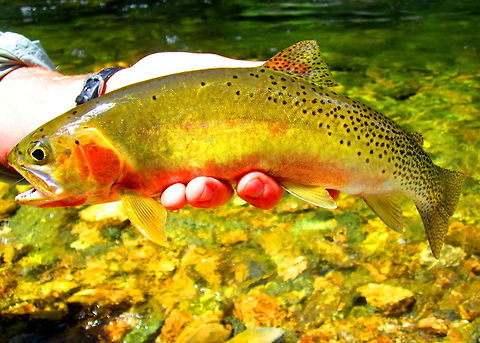
Appearance
The fish has teeth under its tongue, on the roof of the mouth, and in the front of the mouth. Westslope cutthroat are common in both headwaters lake and stream environments. They feed mainly on insects and zooplankton. The average length of the fish is about 8-12 inches and rarely exceeds 18 inches . The skin has small dark freckle-like spots clustered towards the tail, and is mostly orange-hued. They can be distinguished from rainbow trout by the red, pink, or orange marking beneath the jaw .Naming
The westslope cutthroat trout has the trinomial name ''Oncorhynchus clarkii lewisi'', in honor of Meriwether Lewis and William Clark who led the Lewis and Clark Expedition of 1804–1806. The expedition discovered the subspecies at Great Falls of the Missouri in what is now Montana. One of Lewis and Clark’s missions was to bring back word and samples of the flora and fauna encountered during the expedition.Status
The westslope cutthroat trout is an indicator species of the health of the entire ecosystem of its habitat. It requires pure, cold water for survival, secure connected habitat , and protection from introduced nonnative fish. When these requirements are not met, the number of individuals plummets. The subspecies is also in danger of hybridization and may in fact disappear from the Northern Rockies without a region wide, long-term effective protection and recovery effort.Pure westslope cutthroat are extirpated throughout most of their historic range, and existing populations are in imminent danger from land-use activities and hybridization with introduced rainbow trout and Yellowstone cutthroat trout. Even the strongest populations in Glacier National Park and the Flathead Basin of Montana are in serious decline. Reasons for the critical condition of the subspecies include habitat destruction from logging, road building, grazing, mining, urban development, agriculture and dams, introduction of non-native hatchery strains, competition and hybridization from introduced non-native fish species.
The Northern Rockies conservation community’s campaign to protect and recover the westslope cutthroat trout involves a broad coalition of scientists, conservationists, American heritage historians, the sportfishing community, the arts and humanities community, representatives of Native American and ranching communities, and politicians.
References:
Some text fragments are auto parsed from Wikipedia.